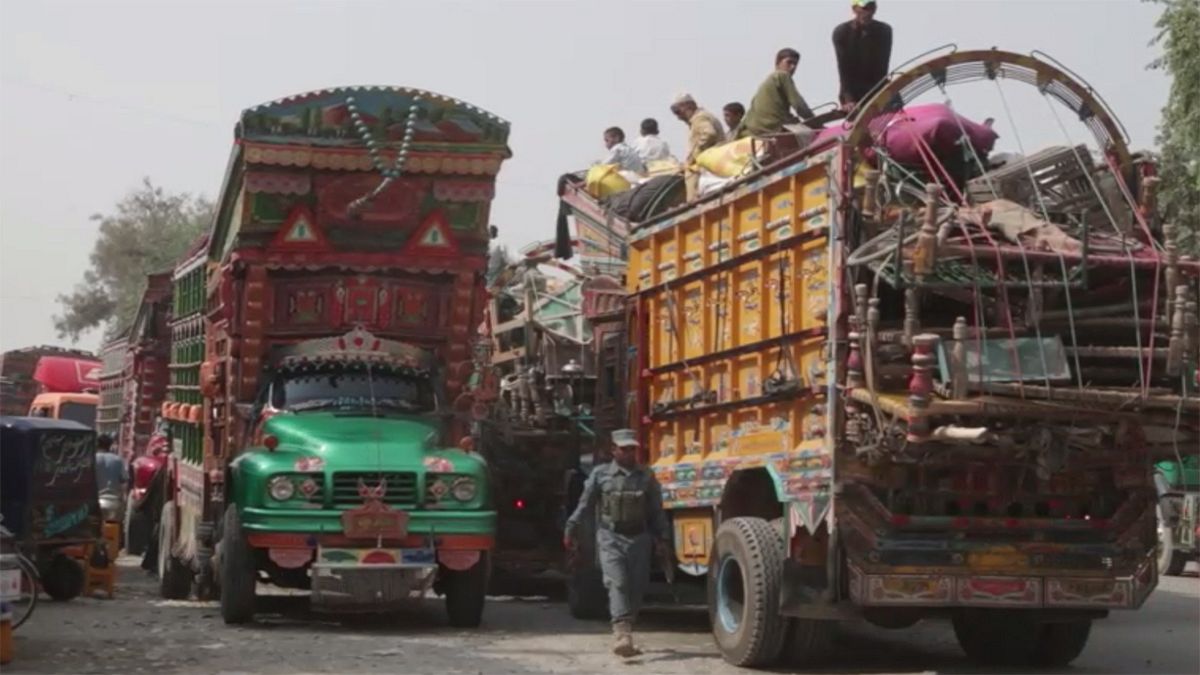More than half a million Afghans were expected to return to their war-torn country by the end of 2016 following Pakistan’s deadline to repatriate Afghan…
More than half a million Afghans were expected to return to their war-torn country by the end of 2016 following Pakistan’s deadline to repatriate Afghan refugees.
Euronews went to Jalalabad to find out what is being done to avoid a humanitarian emergency.
Effective border monitoring has become a problem.
Around 300 families a day register at the encashment centre in Samarkhel.
“We migrated to Pakistan because here was war, our home was destroyed, some of our relatives were martyred,” Mohamad Qadur told Euronews. He was eight years old when he fled to Pakistan during the Soviet invasion.
“This is why we migrated to Pakistan and spent 38 years over there,” he continued. “We were not able to buy a place there, houses were expensive in cities and even in villages. We couldn’t come to Afghanistan and now we were obliged to and under pressure. So we came back.”
Afghans with the appropriate documents are given a repatriation grant of 400 dollars each at the encashment centre in Qadur.
Undocumented returnee families get a one-month support package at the border in Torkham. The stop at the enchashment centre takes less than a day. The UNHCR helps in multiple ways, as the refugee agency’s field associate Abdul Wali explained:
“Assistance includes cash related assistance, and other services linked to the repatriation activities such as mine briefing, vaccination program, health facilities, verifications. In addition to that, we are here to provide to families legal counseling, and any family whose land is disputed we have entities to follow up over the disputed issues”.
UN warns of humanitarian crisis as 7,400 Afghan refugees cross border from Pakistan daily, 15-year US war drags on https://t.co/6ra0vedwTR
— Ben Norton (@BenjaminNorton) October 13, 2016
The spike in the returnees settling in urban centres and semi-urban areas, especially in Nangarhar, is pushing the situation into an acute humanitarian emergency, especially if needs are not met before the winter. The movement of people is unprecedented.
Increased repatriations
Pierre Prakash, Regional Information Officer, EU Humanitarian Aid told Euronews: “We have now more people returning on a daily basis than we had in the entire first six months of the year and this has been going on since the month of July. We now have 145,000 refugees who have returned this year, and this is only official refugees what we called documented refugees who have a refugee status in Pakistan. But you also have over a million a half people, Afghan people in Pakistan who don’t have that status and who are also returning.”
Internally displaced people
The problem doesn’t just involve returnees, but also people fleeing conflict areas inside Afghanistan, internally displaced people.
Pakistan’s Afghan refugees: A timeline https://t.co/EaPIC5Anxz
— Indrika Ratwatte (@IndrikaRatwatte) October 7, 2016
Between January and September, 276,000 newly displaced people were registered. That figure that is expected to rise and adds to an existing situation of over a million internally displaced due to this decades-long conflict.
Why Is Pakistan Expelling Afghan Refugees?
Diplomat_APAC</a> <a href="https://t.co/rE8gRWq5KT">https://t.co/rE8gRWq5KT</a></p>— Nando Sigona (nandosigona) October 10, 2016
Euronews met Alam Gul in the village of Gande Chichma, next to Jalalabad. He came here three months ago when he had to flee the Afghan district of Achin, which borders Pakistan.
“Daesh came after the Taliban,” he explained. “They fought with the Taliban and Daesh (ISIL) destroyed them. Then they captured the whole Achin district. Shops and businesses were totally closed. Most of our neighbours were killed or injured and their assets were looted [by ISIL].”
Alam and his family were given the equivalent of 200 euros from the Danish Refugee Council (DRC), which they used to pay for flour and medical treatments. We followed Zahra, a DRC field officer, to Surkh Rod, another district close to Jalalabad. There she met a family that had received help just a few weeks before.
“The evaluation is important to know whether the cash distributed to them was enough or not? We ask them to know whether they face problem during getting aid we ask them whether they face any kind of problem or not,” she told Euronews.
The facilities here still doesn’t allow for proper registration or screening of households. There is a lack of land allocation schemes and shelter capacity. Funding is still insufficient to take on all the vulnerable undocumented returnees.
Improved understanding of Afghan displacement and migration, and a stronger evidence base, is needed. #AfghanConfhttps://t.co/1zWIpkVB4r
— DanishRefugeeCouncil (@DRC_dk) October 5, 2016
